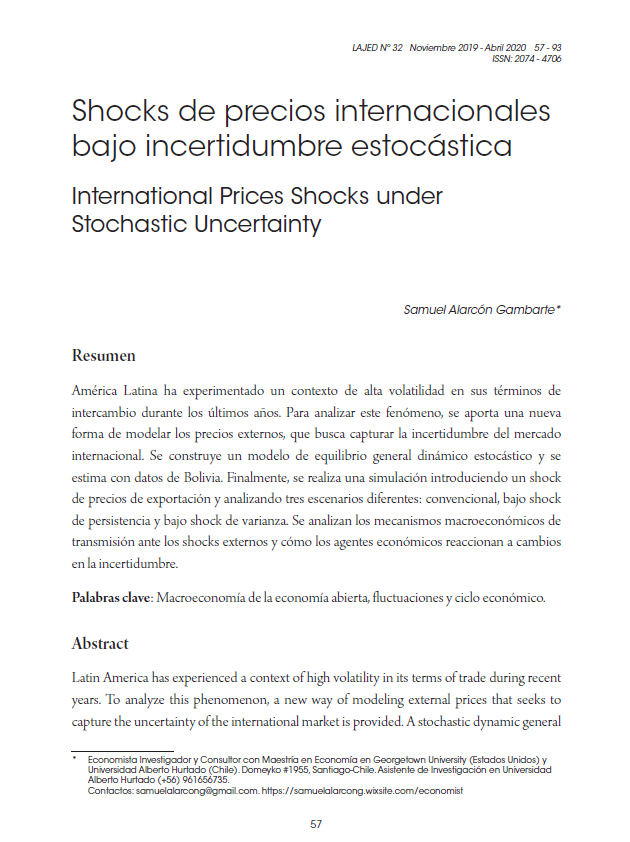International Prices Shocks under Stochastic Uncertainty
DOI:
https://doi.org/10.35319/lajed.201932399Keywords:
Macroeconomics of the open economy, fluctuations and economic cycleAbstract
Latin America has experienced a context of high volatility in its terms of trade in recent years. To analyze this phenomenon, a new way of modeling external prices is provided, which seeks to capture the uncertainty of the international market. A stochastic dynamic general equilibrium model is constructed and estimated with data from Bolivia. Finally, a simulation is carried out by introducing an export price shock and analyzing three different scenarios: conventional, low persistence shock and low variance shock. Macroeconomic transmission mechanisms are analyzed in the face of external shocks and how economic agents react to changes in uncertainty.
Downloads
References
Aguirre, E. (2011). “Business cycles in emerging markets and implications for the real exchange rate”. Doctoral dissertation, Ph. D. Dissertation, New York: Columbia University.
Andrews, D. y Rees, D. (2009). “Macroeconomic volatility and terms of trade shocks” (Nº rdp2009-05). Reserve Bank of Australia.
Bernanke, B. S., Gertler, M., Watson, M., Sims, C. A. y Friedman, B. M. (1997). “Systematic monetary policy and the effects of oil price shocks”. Brookings Papers on Economic Activity, (1), 91-157.
Blanchard, O. J. y Gali, J. (2007). “The Macroeconomic Effects of Oil Shocks: Why are the 2000s so different from the 1970s?” (Nº w13368). National Bureau of Economic Research.
Blattman, C., Hwang, J. y Williamson, J. G. (2007). “Winners and losers in the commodity lottery: The impact of terms of trade growth and volatility in the Periphery 1870-1939”. Journal of Development Economics, 82(1), 156-179.
Bleaney, M. y Greenaway, D. (2001). “The impact of terms of trade and real exchange rate volatility on investment and growth in sub-Saharan Africa”. Journal of Development Economics, 65(2), 491-500.
Bodenstein, M., Erceg, C. J. y Guerrieri, L. (2011). “Oil shocks and external adjustment”. Journal of International Economics, 83(2), 168-184.
Broda, C. (2001). “Coping with terms of trade shocks: Pegs vs. Floats”. American Economic Review, 91 (2), 376-380.
---------- (2003). “Terms of trade and exchange rate regimes in developing countries”. Journal of International Economics, 63(1), 31-58.
Camacho, M. y Pérez-Quiros, G. (2014). “Commodity prices and the business cycle in Latin America: Living and dying by commodities?” Emerging Markets Finance and Trade, 50(2), 110-137.
Cavalcanti, T. V. de V., Mohaddes, K. y Raissi, M. (2015). Commodity price volatility and the sources of growth. Journal of Applied Econometrics, 30(6), 857-873.
Collier, P. y Goderis, B. (2012). “Commodity prices and growth: An empirical investigation”. European Economic Review, 56(6), 1241-1260.
Deaton, A. y Miller, R. I. (1995). International commodity prices, macroeconomic performance, and politics in Sub-Saharan Africa. Princeton, NJ: International Finance Section, Department of Economics, Princeton University.
Easterly, W., Islam, R. y Stiglitz, J. (2000, January). “Explaining growth volatility”. Annual World Bank Conference on Development Economics 2000. Oxford, UK: Oxford University Press.
Farías, L. y Alves da Silva, M. E. (2017). Commodity Prices and Business Cycles in Small Open Economies: The Role of News Shocks. In Working paper.
Fernández, A., González, A. y Rodríguez, D. (2018). "Sharing a ride on the commodities roller coaster: Common factors in business cycles of emerging economies”. Journal of International Economics, (111), 99-121.
Fernández-Villaverde, J. y Rubio-Ramírez, J. (2010). "Macroeconomics and volatility: Data, models, and estimation” (Nº w16618). National Bureau of Economic Research.
Fornero, J. y Kirchner, M. (2018). “Learning about Commodity Cycles and Saving- Investment Dynamics in a Commodity-Exporting Economy”. International Journal of Central Banking, 14(2), 205-262.
Fornero, J. A., Kirchner, M. y Yany, A. (2016). Terms of trade shocks and investment in commodity-exporting economies. Banco Central de Chile.
García-Cicco, J., Pancrazi, R. y Uribe, M. (2010). “Real business cycles in emerging countries?” American Economic Review, 100(5), 2510-31.
Gómez-González, P. y Rees, D. (2013). "Stochastic Terms of Trade Volatility in Small Open Economies”. Economic Research Department, Reserve Bank of Australia.
Greenwood, J., Hercowitz, Z. y Huffman, G. W. (1988). “Investment, capacity utilization, and the real business cycle”. The American Economic Review, 78(3), 402-417.
Gruss, B. (2014). “After the boom–commodity prices and economic growth in Latin America and the Caribbean”. Working Paper 14/154. International Monetary Fund.
Hamilton, J. D. (1994). “State-space models”. Handbook of econometrics, (4), 3039-3080.
Harberger, A. C. (1950). “Currency depreciation, income, and the balance of trade”. Journal of Political Economy, 58(1), 47-60.
Kilian, L. y Lewis, L. T. (2011). “Does the Fed respond to oil price shocks?” The Economic Journal, 121(555), 1047-1072.
Kilian, L. (2008). “The economic effects of energy price shocks”. Journal of Economic Literature, 46(4), 871-909.
---------- (2009). “Not all oil price shocks are alike: Disentangling demand and supply shocks in the crude oil market”. American Economic Review, 99(3), 1053-69.
Kose, M. A. y Riezman, R. (2001). “Trade shocks and macroeconomic fluctuations in Africa”. Journal of Development Economics, 65(1), 55-80.
Kose, M. A. (2002). “Explaining business cycles in small open economies: ‘How much do world prices matter?’”. Journal of International Economics, 56(2), 299-327.
Laursen, S. y Metzler, L. A. (1950). “Flexible exchange rates and the theory of employment”. The Review of Economics and Statistics, (32), 281-299.
Lombardi, M. J., Osbat, C. y Schnatz, B. (2012). “Global commodity cycles and linkages: a FAVAR approach”. Empirical Economics, 43(2), 651-670.
Mendoza, E. G. (1995). “The terms of trade, the real exchange rate, and economic fluctuations”. International Economic Review, 36(1),101-137.
Obstfeld, M. (1981). “Macroeconomic policy, exchange-rate dynamics, and optima asset accumulation”. Journal of Political Economy, 89(6), 1142-1161.
Raddatz, C. (2007). “Are External Shocks Responsible for the Instability of Output in Low-Income Countries?”. Journal of Development Economics 84(1), 155-187.
Schmitt-Grohe, S. y Uribe, M. (2003). “Closing small open economy models”. Journal of International Economics, 61(1), 163-185.
---------- (2018). “How Important are Terms‐Of‐Trade Shocks?”. International Economic Review, 59(1), 85-111.
Shousha, S. (2016). “Macroeconomic effects of commodity booms and busts: The role of financial frictions”. Unpublished Manuscript.
Svensson, L. E. y Razin, A. (1983). “The terms of trade and the current account: The Harberger-Laursen-Metzler effect”. Journal of Political Economy, 91(1), 97-125.






